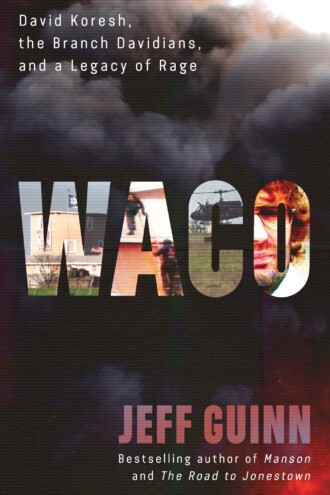Jeff Guinn was first a newspaperman, which included a stint at the Fort Worth Star-Telegram, before he took on narrative nonfiction. His latest book comes as the country approaches the 30th anniversary of the 51-day siege at the Branch Davidian compound in Waco that culminated in a fiery death for its leader, David Koresh, and many of his followers and their children.
In Waco: David Koresh, the Branch Davidians, and a Legacy of Rage, Guinn interviewed government agents and survivors. He also spent time delving into Koresh, trying to make sense of how he came to believe he was a prophet, and how the standoff at the Mount Carmel compound and the aftermath actually fed the hopes of many who believed those prophecies.
While exploring Koresh’s life for the book, Guinn also discovered that his subject plagiarized all of his major prophecies from Cyrus Teed, another self-styled prophet named Koresh who lived in Florida in the early 1900s. In Teed’s case, the confrontation with the agents of Babylon came in the form of a fight that eventually ended up with Teed being beaten by the town marshal. He sustained some injuries and died about two years later.

While David Koresh may have subconsciously pilfered Teed’s prophecies, he very much believed them, Guinn said. That he did, and was able to convince people to follow him, is also part of Guinn’s dissection of the motives and psychology that led to the raid at Mount Carmel.
The standoff began on February 28, 1993, when agents with the Federal Bureau of Investigations and the Bureau of Alcohol, Tobacco, and Firearms tried to serve a search warrant on the property. When a gunfight broke out and killed four law-enforcement agents and six Branch Davidians, it began a siege that lasted until April 19, when federal agents moved to raid the compound, which caught fire. During that raid and fire, 76 Branch Davidians (including at least 20 children) died.
In addition to explaining the very different understandings of the situation between the federal agents (who were looking at the situation at Mount Carmel from a legal standpoint) and the Branch Davidians (who felt God told them to get ready for a fight against Babylon’s agents), Guinn also spends time looking at how the standoff fed modern anti-government extremist groups.
The book was released this week. We sat down with Guinn shortly before he embarked on a book tour. The conversation has been edited for brevity and clarity.
When I mentioned that I was going to be interviewing you about this book, more than a few people asked me if there was new ground to cover on the siege.
There were just a couple of obvious things that everyone was obsessed with so much, and that got all the coverage. And I think one of the ways you can tell that there’s more information to be found is that ever since what happened there 30 years ago, there have been all kinds of conspiracy theories that have just strengthened through the years—right up to the armed militias and the things that happened on January 6, with people citing that getting revenge for Mount Carmel was what got them going in the first place.
When you look at what happened in 1993 in Waco, there are so many things that have only been generally assumed about the rules of the ATF. Beyond that, there are stereotypes, and everyone has an opinion. Either a bunch of bloodthirsty government agents slaughtered some innocent Bible-believing civilians, or there was a cult full of religious nuts following an obviously insane demagogue who, if he hadn’t been put down, would have gone out and killed a bunch of people.
I wanted to find out more than just what happened. I wanted to find out why these things happened, and how they happen. And that opened up a whole new world of revelations. ATF agents and the POAs, or Plain Old Agents, who had been forbidden to ever discuss anything about it decided they wanted to open up and be interviewed for the first time. (Editors note: Plain Old Agents is a distinction that indicates that the agent is a rank-and-file without specialized skills, often called in to complete the manpower needed for an operation.)
They had a lot of documents they provided. So we get the whole ATF perspective for the first time, and see that it was nothing like what common belief says it was. The FBI analyst scribe, who was there during the entire siege, documenting everything that happened—and again had never been able to come forth—gave a great deal of fresh information.
Even the surviving Branch Davidians did. I’m in Denver interviewing with one of the ATF agents, telling him something that surviving Branch Davidian had told me in Florida a couple of days before, and he was saying, “Why did we not know that? If we had known that, we would never have done what we did.” So we have all these moments. We’re giving the whole view now, not just the limited one-sided view.
What kind of reaction have you gotten from people who have read it so far?
One of the things I was curious about after I finished the draft of the book and sent it in to my editor at Simon and Schuster was what was going to be the reaction. What’s going to surprise them the most? I had suspected that the big thing would be that we confirm beyond a shadow of a doubt that everything David Koresh was prophesying, he got word-for-word from a previous Koresh down in Florida. There’s actually written record. I thought that would be the big reaction, that David Koresh was not an original and in fact was a big plagiarist.
But the first thing my editor said to me was, “Jeff, I really like this,” which is something every writer wants to hear. But then he said, “I can’t believe that the ATF, those guys were bringing candy when they went to Mount Carmel.” Which was true.
The agents were doing everything in their power to make sure that there wasn’t any violence and to make sure that the kids didn’t get scared. And that’s what he couldn’t believe. “You mean to tell me these people had feelings?”
And then someone who was working on the design of the book asked me how I could think that everyone was equally victim and equally to blame when the Branch Davidians just believed in God they were sitting around wanting to be left alone. And that wasn’t the case either.
When you take the ATF, the FBI, and the Branch Davidians, those are the three main components of this. Only the Branch Davidians’ agenda required people to die. They needed to kill agents of Babylon and be killed by them to initiate the end of days. Anyone dying absolutely did not fit what ATF or the FBI hoped to accomplish.
But what unfolded was absolutely important to David Koresh, because it fulfilled his prophesy that they would need to fight and kill the agents of Babylon, and that they would need to die, too.
The Branch Davidians were stockpiling a lot of weapons, but there was also a lot of child abuse allegedly going on as well. You had Koresh marrying very young girls. There were discussions about beatings. I think that’s the other thing that people have a hard time understanding how parents could be OK with that.
The surviving Branch Davidians that I have spoken to—and particularly when we talk about the kids allegedly being beaten to the point of endangering their health—everything those people did inside Mount Carmel was absolutely based on what they believe the Bible told them. One of them says in the book, and I think it helps us understand their perspective better, “If you believe in God. And you believe God has told you to do something, wouldn’t you do it?” And if that meant doing something outsiders found appalling, that’s just because outsiders don’t understand, because they’re not in the message.
One of the women who had four kids there, Kathy Schroeder, told the grasshopper story. No one really understood how every action in their lives, everything they did every day, was predicated on what the Bible mandated.
She told me by way of example, “One day one of my sons killed a grasshopper, and I made him eat it.” And I asked, “Why?” And she said, “Well, in Leviticus, the Bible teaches that you may not kill any living thing except to eat it.” If she hadn’t made him eat that grasshopper, he would have been in violation of the rules set down in the Bible. So to save his soul, she made him eat the grasshopper.
The FBI and the AFT agents weren’t thinking about religion when they were carrying this out. They were thinking about the laws that were broken about illegal guns and automatic weapons. So they went in that it was a criminal act.
But the Branch Davidians, even to this day, believe that they were persecuted for their religion because everything they did was based on their faith. But once you understand the perspectives on both sides, you can see neither one is going to change and neither one’s going to understand the other one.
So many who were old enough to remember watching the siege on TV remember, at the very least, the fire at the end and the aftermath. You make this point toward the end of the book that there has always been this faction of people that distrusts the government—that’s always percolating in the background. But you have events like what happened in Waco, and it almost punctuates that distrust, where they can point and say, “See?”
That’s one of the reasons I think Waco is still important. You have the head of the Oath Keepers militia, for instance, claiming that he cut his militia teeth on wanting to get even for what happened in Mount Carmel. You have two years after the fire there, Timothy McVeigh blowing up the federal building in Oklahoma City in retaliation for Mount Carmel.
There are the anniversary observations in Waco that came afterward, which is where Alex Jones came into public prominence, and he sort of takes over the stage at the old site and says, “By God, if this ever happens again, I’m gonna be right there. We’re going to do things about it.” So a lot of the modern orchestration of these things going on has its roots in Waco.
We’re never going to change the minds of people who really want to believe all these awful things. But at least maybe for the people who wonder sometimes, we can show there’s no real conspiracy here. There are people who made terrible decisions. There are a couple of clumsy cover-ups—which gave conspiracy theorists a reason to say, “Well, fine, if they’re lying about this, they’re lying about everything.”
But above all, the more facts—not conjecture—that people have, the better the chance that maybe we could look objectively and things can be learned from the screw-ups.
Author





